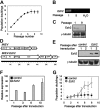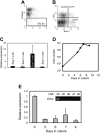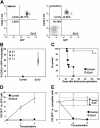The Polycomb group gene Ezh2 prevents hematopoietic stem cell exhaustion
- PMID: 16293602
- PMCID: PMC1895717
- DOI: 10.1182/blood-2005-09-3585
The Polycomb group gene Ezh2 prevents hematopoietic stem cell exhaustion
Abstract
The molecular mechanism responsible for a decline of stem cell functioning after replicative stress remains unknown. We used mouse embryonic fibroblasts (MEFs) and hematopoietic stem cells (HSCs) to identify genes involved in the process of cellular aging. In proliferating and senescent MEFs one of the most differentially expressed transcripts was Enhancer of zeste homolog 2 (Ezh2), a Polycomb group protein (PcG) involved in histone methylation and deacetylation. Retroviral overexpression of Ezh2 in MEFs resulted in bypassing of the senescence program. More importantly, whereas normal HSCs were rapidly exhausted after serial transplantations, overexpression of Ezh2 completely conserved long-term repopulating potential. Animals that were reconstituted with 3 times serially transplanted control bone marrow cells all died due to hematopoietic failure. In contrast, similarly transplanted Ezh2-overexpressing stem cells restored stem cell quality to normal levels. In a "genetic genomics" screen, we identified novel putative Ezh2 target or partner stem cell genes that are associated with chromatin modification. Our data suggest that stabilization of the chromatin structure preserves HSC potential after replicative stress.
Figures

 ) at different passages after transduction. Expression levels of Ezh2 were determined by quantitative PCR and calculated relative to MEFs transduced with control at passage 1 after transduction. (G) Growth of MEFs after retroviral transduction (control, ▪; Ezh2,
) at different passages after transduction. Expression levels of Ezh2 were determined by quantitative PCR and calculated relative to MEFs transduced with control at passage 1 after transduction. (G) Growth of MEFs after retroviral transduction (control, ▪; Ezh2,  .
.

 ) vectors (n = 11 recipients per group, 2 independent experiments). Mean values plus or minus standard error of the mean (SEM) are shown. (B) Chimerism at different time points after transplantation. The percentage of donor-derived transduced CD45.1+GFP+ WBCs is shown. Average values ± 1 SEM of 2 independent experiments are shown. (C) Ezh2 protein expression in the spleen about 120 days after primary transplantation of control or Ezh2 CD45.1 BM cells. (D) CAFC frequencies of sorted LSK GFP+ cells 120 days after primary transplantation (control, ▪; Ezh2,
) vectors (n = 11 recipients per group, 2 independent experiments). Mean values plus or minus standard error of the mean (SEM) are shown. (B) Chimerism at different time points after transplantation. The percentage of donor-derived transduced CD45.1+GFP+ WBCs is shown. Average values ± 1 SEM of 2 independent experiments are shown. (C) Ezh2 protein expression in the spleen about 120 days after primary transplantation of control or Ezh2 CD45.1 BM cells. (D) CAFC frequencies of sorted LSK GFP+ cells 120 days after primary transplantation (control, ▪; Ezh2,  ). (E) Chimerism levels of secondary recipients, competitively transplanted with various ratios (2:1, ⋄; 1:1, ○; 1:2, □; 1:5, ▵) of transduced/nontransduced and freshly isolated BM cells, analyzed 3 months after transplantation. Values show data from individual recipients in 2 independent experiments (n = 35/group). (F) CRI calculated for CD45.1+GFP+ (transduced) versus CD45.1+GFP- (nontransduced) cells (see insert). Values (+ 1 SEM) are averages 3 months after secondary transplantation, based on 11 and 24 individual mice in the first and second experiment, respectively (control, ▪; Ezh2,
). (E) Chimerism levels of secondary recipients, competitively transplanted with various ratios (2:1, ⋄; 1:1, ○; 1:2, □; 1:5, ▵) of transduced/nontransduced and freshly isolated BM cells, analyzed 3 months after transplantation. Values show data from individual recipients in 2 independent experiments (n = 35/group). (F) CRI calculated for CD45.1+GFP+ (transduced) versus CD45.1+GFP- (nontransduced) cells (see insert). Values (+ 1 SEM) are averages 3 months after secondary transplantation, based on 11 and 24 individual mice in the first and second experiment, respectively (control, ▪; Ezh2,  ). (G) CRI calculated for transduced cells (CD45.1+GFP+) compared to freshly isolated BM cells (CD45.2+; see insert). Averages values (+ 1 SEM) of 11 and 24 individual mice of the first and second experiment, respectively, are shown (control, ▪; Ezh2,
). (G) CRI calculated for transduced cells (CD45.1+GFP+) compared to freshly isolated BM cells (CD45.2+; see insert). Averages values (+ 1 SEM) of 11 and 24 individual mice of the first and second experiment, respectively, are shown (control, ▪; Ezh2,  ). (H) LTRA frequencies in CD45.1+GFP+ (transduced) cell fractions calculated from limiting dilution analyses 3 months after secondary transplantation in 2 independent experiments (control, ▪; Ezh2,
). (H) LTRA frequencies in CD45.1+GFP+ (transduced) cell fractions calculated from limiting dilution analyses 3 months after secondary transplantation in 2 independent experiments (control, ▪; Ezh2,  ).
).
 ). (D) CRI comparing transduced CD45.1+GFP+ stem cells versus nontransduced CD45.1+GFP- stem cells in primary, secondary, and tertiary recipients (control, ▪; Ezh2,
). (D) CRI comparing transduced CD45.1+GFP+ stem cells versus nontransduced CD45.1+GFP- stem cells in primary, secondary, and tertiary recipients (control, ▪; Ezh2,  ). (E) CRI comparing transduced CD45.1+GFP+ stem cells with freshly isolated BM cells after 1, 2, and 3 serial transplantations (control, ▪; Ezh2,
). (E) CRI comparing transduced CD45.1+GFP+ stem cells with freshly isolated BM cells after 1, 2, and 3 serial transplantations (control, ▪; Ezh2,  ).
).
 ) allele for marker D18Mit83.
) allele for marker D18Mit83.
Similar articles
-
Dependency on the polycomb gene Ezh2 distinguishes fetal from adult hematopoietic stem cells.Blood. 2011 Dec 15;118(25):6553-61. doi: 10.1182/blood-2011-03-340554. Epub 2011 Oct 31. Blood. 2011. PMID: 22042701
-
Polycomb group protein-associated chromatin is reproduced in post-mitotic G1 phase and is required for S phase progression.J Biol Chem. 2008 Jul 4;283(27):18905-15. doi: 10.1074/jbc.M709322200. Epub 2008 May 2. J Biol Chem. 2008. PMID: 18453536
-
Lysine-specific demethylase 2B (KDM2B)-let-7-enhancer of zester homolog 2 (EZH2) pathway regulates cell cycle progression and senescence in primary cells.J Biol Chem. 2011 Sep 23;286(38):33061-9. doi: 10.1074/jbc.M111.257667. Epub 2011 Jul 11. J Biol Chem. 2011. PMID: 21757686 Free PMC article.
-
Epigenetic control of hematopoietic stem cell aging the case of Ezh2.Ann N Y Acad Sci. 2007 Jun;1106:233-9. doi: 10.1196/annals.1392.008. Epub 2007 Mar 1. Ann N Y Acad Sci. 2007. PMID: 17332078 Review.
-
EZH2 in normal hematopoiesis and hematological malignancies.Oncotarget. 2016 Jan 19;7(3):2284-96. doi: 10.18632/oncotarget.6198. Oncotarget. 2016. PMID: 26497210 Free PMC article. Review.
Cited by
-
The pleiotropic roles of EZH2 in T-cell immunity and immunotherapy.Int J Hematol. 2022 Dec;116(6):837-845. doi: 10.1007/s12185-022-03466-x. Epub 2022 Oct 21. Int J Hematol. 2022. PMID: 36271224 Review.
-
Arginine methyltransferase PRMT5 is essential for sustaining normal adult hematopoiesis.J Clin Invest. 2015 Sep;125(9):3532-44. doi: 10.1172/JCI81749. Epub 2015 Aug 10. J Clin Invest. 2015. PMID: 26258414 Free PMC article.
-
Attenuated Acceleration to Leukemia after Ezh2 Loss in Nup98-HoxD13 (NHD13) Myelodysplastic Syndrome.Hemasphere. 2019 Aug 7;3(4):e277. doi: 10.1097/HS9.0000000000000277. eCollection 2019 Aug. Hemasphere. 2019. PMID: 31723847 Free PMC article.
-
Epigenetic dysregulation in cancer.Am J Pathol. 2009 Oct;175(4):1353-61. doi: 10.2353/ajpath.2009.081142. Epub 2009 Aug 28. Am J Pathol. 2009. PMID: 19717641 Free PMC article.
-
Genome-wide mapping of Polycomb target genes unravels their roles in cell fate transitions.Genes Dev. 2006 May 1;20(9):1123-36. doi: 10.1101/gad.381706. Epub 2006 Apr 17. Genes Dev. 2006. PMID: 16618801 Free PMC article.
References
-
- Mauch P, Hellman S. Loss of hematopoietic stem cell self-renewal after bone marrow transplantation. Blood. 1989;74: 872-875. - PubMed
-
- Nakauchi H, Sudo K, Ema H. Quantitative assessment of the stem cell self-renewal capacity. Ann N Y Acad Sci. 2001;938: 18-24. - PubMed
-
- Lund AH, van Lohuizen M. Polycomb complexes and silencing mechanisms. Curr Opin Cell Biol. 2004;16: 239-246. - PubMed
Publication types
MeSH terms
Substances
Grants and funding
LinkOut - more resources
Full Text Sources
Other Literature Sources
Medical

